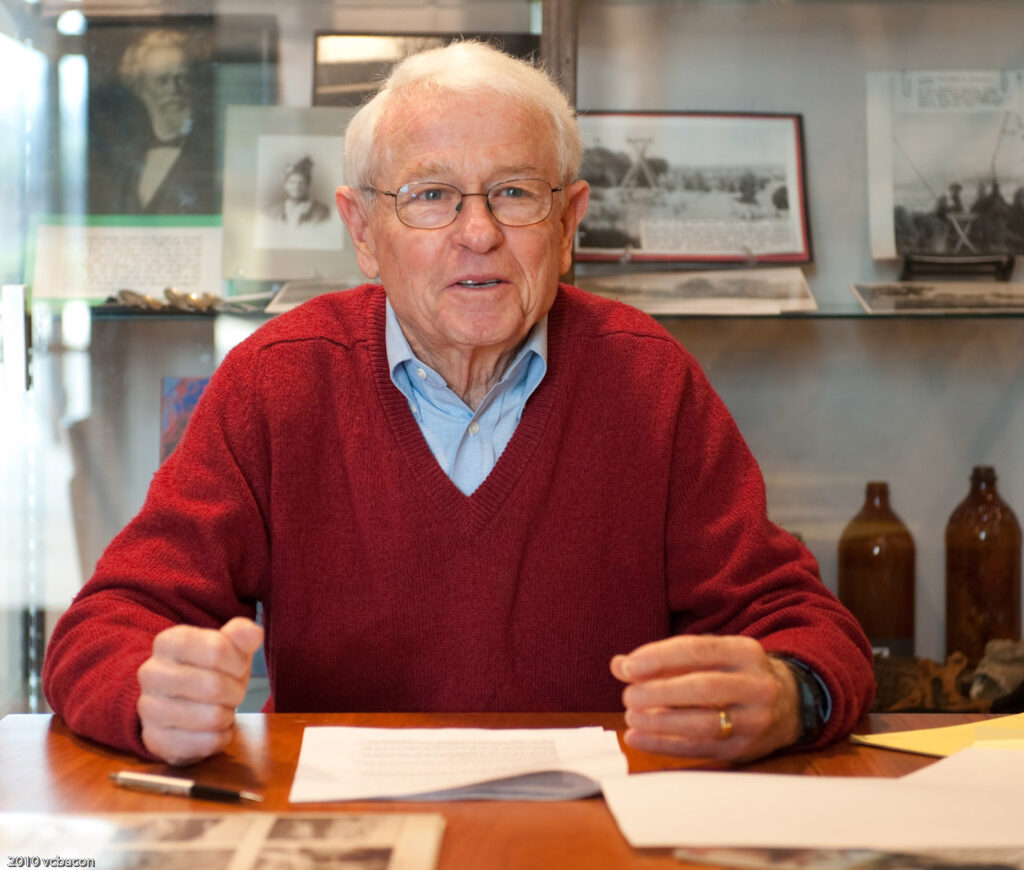Integrated geologic hazards information with land-use planning
By Laurie A. Johnson PhD, FAICP, November 5, 2022

George Mader, FAICP, passed away on July 28, 2022 — his 93rd birthday. In his remarkable six-decades-long career, George was widely recognized for his extensive work in integrating geologic hazards information with land-use planning. He pioneered the development of slope-density zoning and the transfer of development credits, both of which have been used widely in geologically hazardous and environmentally sensitive communities across California and beyond. For his leadership in this area, Mader was inducted into the College of Fellows of the American Institute of Certified Planners in 2003 and received Distinguished Leadership Awards from Northern Section and California Chapter of the American Planning Association (APA) in 2010. For his contributions to the field of earthquake risk reduction, George was awarded the Alfred E. Alquist Special Recognition Medal by the Earthquake Engineering Research Institute (EERI) in 2013 and, in 2011, he was invited to have his Oral History recorded, one of EERI’s highest honors (see Connections: The EERI Oral History Series, Vol. 22: George G. Mader (2014)).
After receiving a BA in geography from UCLA (1952) and serving in the military for two years, George graduated with a Master in City and Regional Planning from UC Berkeley (1956). His first job, 1955-1958, was as associate planner on the special staff that prepared the San Mateo County General Plan. From 1959 to 1962 he was senior planner in charge of the current planning division for San Mateo County. In 1962, Mader joined William Spangle & Associates, later Spangle Associates, where George led cutting-edge planning and research until his retirement in 2014.
Spangle Associates provided planning administration support to the Town of Portola Valley from the time of its incorporation in 1964 until 2014, and Mader served as Town Planner from 1965 to 2010. The Town’s innovative approaches to geologic hazards mapping, earthquake fault zoning, and the integration of geologic information into land use planning and development have received national and international acclaim and were the subject of the National Science Foundation study that George led: Geology and Planning: The Portola Valley Experience (1988). Mader was also a principal investigator of several of Spangle Associates’ landmark research studies, including Land Use Planning After Earthquakes (1980), Pre-Earthquake Planning for Post-Earthquake Recovery (1987), and Rebuilding after Earthquakes – Lessons for Planners (1991) for which the firm received a Distinguished Leadership Award from the California Chapter of APA.
Mader taught city and regional planning courses for UC Extension, Berkeley, 1960-1964, and was a lecturer in UC’s Department of City and Regional Planning, 1967-1970. In 1970, George was invited to develop a yearlong course at Stanford University in the use of earth sciences in urban planning which he taught as a senior lecturer until 2000. He received the Award for Excellence in Teaching from Stanford’s School of Earth Sciences in 1992.
Mader was an investigator and advisor following major international earthquakes, including China (1976), Italy (1980), Algeria (1982), Mexico City (1985), and Turkey (1999), as well as the San Fernando (1971), Whittier (1985), Loma Prieta (1989), and Northridge (1994) earthquakes in California. He worked with planners in the replanning of Ech Cheliff following the 1980 Algerian earthquake and with the United Nations on seismic hazard reduction across the Mediterranean region. He was part of the first, comprehensive earthquake risk management study for Quito, Ecuador, and helped develop earthquake hazard reduction planning mechanisms for cities in Turkey.
His public service on more than 30 state and national committees and commissions included the Advisory Group on Land Use Planning to the Joint Committee on Seismic Safety of the California Legislature (1969-1974), California Seismic Safety Commission (1975-1984), California Governor’s Emergency Task Force on Earthquake Preparedness (1981-1982), Bay Area Regional Earthquake Preparedness Project Policy Advisory Board (1984-1992), Project Oversight Committee for the National Institute of Building Standards Earthquake Loss Estimation Methodology Study (1993-1998), and National Research Council Committees on Seismic Policy Adoption and Implementation, Science and Technology in Emergency Management, and Ground Failure Hazard Mitigation Research.
In his later years, George served on the Board of Trustees of GeoHazards International and established the George Mader Fund for a Safer Environment to bring a legacy of thoughtful help to vulnerable communities in poor countries.
Mader is survived by his wife of 66 years, Marjorie Mader, his three children — Steve Mader, Ann Stillman, and Philip Mader — and their families.

